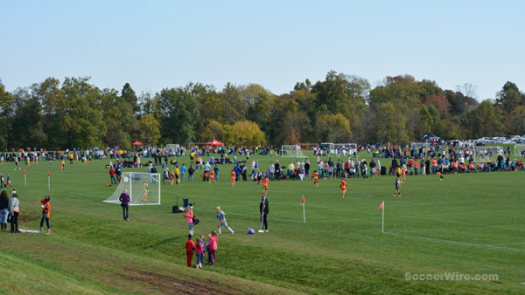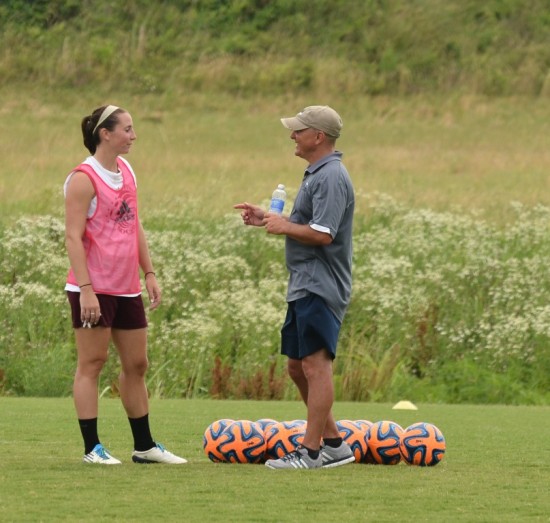Creating an early engagement model in North American youth soccer
 A few weeks back, I wrote about the popular misconception that early specialization is the key to success in soccer. I argued that in fact early engagement is the path that the world’s most exciting players take, a path predicated on child-directed free play, creativity and freedom to fail.
A few weeks back, I wrote about the popular misconception that early specialization is the key to success in soccer. I argued that in fact early engagement is the path that the world’s most exciting players take, a path predicated on child-directed free play, creativity and freedom to fail.
Engagement is a path that increases intrinsic motivation, ownership and enjoyment, the building blocks of the sustained sport participation needed to play at an elite level. And boy, did my piece generate quite a few comments and discussion.
+READ: O’Sullivan – The early specialization dilemma in North American soccer
Today I want to discuss how we can end the early specialization path in North American youth soccer, and create an early engagement path where kids want to play, instead of a specialization path where they have to play.
Our current model is terribly broken because it pushes kids down the early specialization path, which imposes financial, physical, psychological and commitment barriers upon so many children and families. We force kids to choose way too early, and thus we narrow the player pool because some kids leave before they ever get started. Remember from my last article that 20 percent of all U.S. 6-year-olds play soccer, and we lose nearly 40 percent of them by age 12! Soccer very quickly goes from being about joyful pursuit to a job. And then many kids quit.
Specialization is not good for our children’s health. It’s not good for their psyche. It is less likely to create better players than it is to create bitter players who get hurt, burn out and quit. Simply put, it is not good growth of the game, and it’s not good for player development.
As a former player, coach and huge fan of the game and its growth in the U.S., I want to see the game grow and succeed. I want us to win a World Cup. But to do so, we must make the game more inclusive. We must make it and keep it accessible to all who want to play, instead of only those who can afford to play. We must make a place for every player of any ability to participate in and grow the game. We need to scrap the specialization and create an early engagement model.
Here are 5 Keys to Building an Early Engagement Model in the US
1) We must get away from “elite” teams, travel and long-distance interclub play prior to age 12. Cutting kids, forming elite travel teams, and then requiring excessive commitments of those kids at very young ages (some states start at U-7) creates massive barriers to entry and participation. We basically force kids out of the game and put up a “Not Welcome” sign for so many potential young players who are sampling sports and cannot afford the time and financial commitment.
Now for those who say “we are teaching them to be competitive,” that is a load of BS. High player fees, expensive out-of-town trips, and $300 uniform packages do not make players more competitive; they make adults more competitive! Save yourselves a lot of money and time by playing close to home in an inexpensive uniform, with less high-intensity, win-or-go-home games, add more practices and free play, and players will engage with the game.
 2) Replace these travel teams with more in-house, academy-style training and play, with perhaps a few festival-type weekends of soccer fun, futsal, 3v3, etc., and put your best coaches with these kids. This will enable your best coaches to have contact with larger pools of players, exposing them to good coaching and speeding the development of many players, instead of a select few.
2) Replace these travel teams with more in-house, academy-style training and play, with perhaps a few festival-type weekends of soccer fun, futsal, 3v3, etc., and put your best coaches with these kids. This will enable your best coaches to have contact with larger pools of players, exposing them to good coaching and speeding the development of many players, instead of a select few.
Instead of selecting year-round teams, offer four sessions a year (winter, spring, summer, fall) and let kids could come and go as they please after each session. There would be no need to keep teams together year round (allowing for ample player movement), but a strong incentive to create a playing environment where players wanted to come back. It would be an environment where kids could sample many sports, and would be less likely to be injured or burned out.
They would become better athletes, and then still have the opportunity to pick elite level soccer when they re ready to choose. Compare this to our current system, where we tell them at U-9, “it’s now or never, time to commit for a year,” and as a result we lose many of the top athletes who are not ready to choose yet. This model creates a place in our game for the late bloomers and the multi-sport samplers.
+READ: LeBolt – What’s so wrong with early specialization?
It is OK to tier players and have different levels of training and even playing groups in this format, as long as there is constant player movement allowed. Anyone who has coached young players has seen how quickly an engaged player can improve, yet our current system relegates that child to the “B” team for an entire year for no reason at all.
Imagine having 60-100 quality players to choose from at a U-13 tryout, all of whom have been coached well for four to six years by your club, instead of selecting from an increasingly dwindling pool of players from three years of travel teams and cuts (or having to poach from other clubs to form your team)?
3) Make game days all-inclusive! One of the top reasons kids quit sports is because of a lack of playing time, yet we fill rosters to their max and have players sitting out, and are hamstrung by our competitive league rules that do not allow us to adapt and increase participation. I believe the number of players sitting on the bench at any one time on game days is the most overlooked destructive force in youth soccer today. I am not talking about playing full-sided games here, but being flexible based upon numbers on game day.
 For example, instead of playing 8v8 with 14 player rosters and 12 kids sitting out at any one time – so we can keep standings and play “real games” at U-9 – imagine we did something different. Would it not be better if those same two groups played two 6v6 cross-field games and had 12 of the 14 players participating at any given moment? Show up one week and play 6v6, and then the next week play 3v3.
For example, instead of playing 8v8 with 14 player rosters and 12 kids sitting out at any one time – so we can keep standings and play “real games” at U-9 – imagine we did something different. Would it not be better if those same two groups played two 6v6 cross-field games and had 12 of the 14 players participating at any given moment? Show up one week and play 6v6, and then the next week play 3v3.
The kids would love it because they are playing instead of sitting. They would play more, get more touches, and become better players. Parents might chill out a bit because their coach is the ref, the games are small-sided, and there are no standings. As for coaches, well, no more worrying about managing playing time and playing for the win. You can just let them play, create, fail, and do it all again.
4) Start focusing on and investing in coaching development at the grassroots level. We lose millions of players between the ages of 6 and 12! At the ages where our best coaches can have the biggest impact, the best coaches are absent! We hand that responsibility to volunteer moms and dads with great intentions but quite often no playing or coaching experience. And then we email or hand them a PDF at the preseason coaching meeting and call it good. We lose kids before they every have access to a trained, experienced coach.
Throughout the world, I see a much greater value placed on coaching education, as well as a focus on placing highly talented and experienced coaches with the introductory players. In Iceland, for example, over 50 percent of coaches have a UEFA B License or better, and many of these coaches are working with 5- and 6-year-olds. A premium is placed upon quality coaching for all ages. That is why Iceland, a country of 350,000 people, was recently able to defeat mighty Holland in a competitive international match.
+READ: Adult obsession with winning is killing youth sports in America
We can also start using technology to help these coaches. Check out www.TheDrillBook.com for a great free web and app resource for your grassroots coaches with age appropriate prebuilt practices and full-season plans (full disclosure: I am a contributor to TDB).
5) Invest in continuing parent education for your club. If you want your team to play out of the back, you don’t simply work on it once; you go over it again and again. This makes total sense, yet somehow we think that parents will know how to act on the sidelines and how to help their kids and coaches if we go over it once, or make them sign a silly code of conduct at the beginning of the year. How’s that working for you?
We must teach parents how to help during these formative years, at a time when they are not so focused on results. Education will help them to let go and let the experience belong to the kids. Teach them to let their kids fail, teach them what to say on the sideline, and create a child-centered culture in your club that tells the over-the-top, win-at-all-costs parents, “shape up or ship out, because that is not how we do things here.” Today we just hope it will happen, that it will come naturally, but where is that getting us?
 These five actions can help us build an early engagement path for our players that will grow their love of the game by letting players develop on their own pace, and commit on their own schedule. They will build intrinsic motivation and enjoyment. This model will prove less costly in terms of money and time for families trying to balance multiple kids and multiple activities.
These five actions can help us build an early engagement path for our players that will grow their love of the game by letting players develop on their own pace, and commit on their own schedule. They will build intrinsic motivation and enjoyment. This model will prove less costly in terms of money and time for families trying to balance multiple kids and multiple activities.
Most importantly, these five steps will give us a much larger pool of trained athletes to choose from at ages where players are prepared to take on the training and commitment level necessary to go to the next level. It is a far better path.
We need some clubs and some leagues to be brave and become early adopters. We must overcome the fear that we will lose our players to the club next door that is picking the “elite” team, and travelling thousands of miles to put kids in environments that take away their love of the game. Yes, we will lose some kids to those clubs, but in the long run, you will gain many more players, and serve them well.
We need to do what is right for our players based on sound science, and this path is sound science. Early specialization is a developmental system that serves the whims of the parent who screams the loudest and parades their child’s trophy-laden image across social media.
Early engagement serves the kids! And it serves the game.
+READ: LeBolt: Should your kid be a specialist, or general practitioner?
My hope here is not to have the last word, but start a proper discussion on what is the correct path in this country for producing not only elite players, but growing the game and the fan base for the future, for only through the growth of the game will we ever be a world power. Early specialization is NOT that path.
 If you want your child to have the best chance to stay free of injury, motivated to play, and fall in love with the game, find a club that offers a path of early engagement. Step back and encourage more free play, greater child ownership, and space for other activities and sports. Have the patience to let your children find the sport that is best physical, social and psychological fit for them.
If you want your child to have the best chance to stay free of injury, motivated to play, and fall in love with the game, find a club that offers a path of early engagement. Step back and encourage more free play, greater child ownership, and space for other activities and sports. Have the patience to let your children find the sport that is best physical, social and psychological fit for them.
I love the game of soccer, and I know that when it is set up right, it is a sport that children will gravitate to because it is a players game, and it values both individualism and teamwork, both creativity and industry.
It has all the ingredients to become the most popular game in our land, if we just get out of the way.
SOCCERWIRE MARKETPLACE
- MANCHESTER CITY SOCCER CAMPS
- FC Bayern Soccer Camps - $30 PROMO CODE: BMSOCCERWIRE
- Real Colorado Cup 2026
- Join a College Coaches Showcase Camp Today
- MICFootball Punta Cana 2026
- Dana Cup Hjørring 2026
- 15th Annual Loudoun Soccer College Showcase
- OFFICIAL FC BARCELONA SOCCER CAMPS - PROMO CODE: FCBSOCCERWIRE
- New England Copa Surf 2026
- Adidas National Cup 2026











